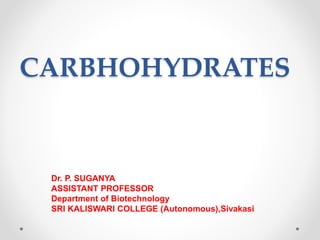
Carbohydrates: Classification, Structure and Functions
- 1. CARBHOHYDRATES Dr. P. SUGANYA ASSISTANT PROFESSOR Department of Biotechnology SRI KALISWARI COLLEGE (Autonomous),Sivakasi
- 2. Definition • Carbohydrates are most abundant biomolecules in the nature • Carbohydrates are molecules that contain carbon, hydrogen, and oxygen. • There are twice as many hydrogen atoms as carbon or oxygen atoms. • The general formula for a carbohydrate can be written as Cx(H2O)y. • They act as the source of energy (e.g. glucose), as a store of energy (e.g. starch and glycogen) and as structural units (e.g. cellulose in plants and chitins in insects).
- 3. Functions • Carbohydrates are involved in various functions: • They also act as precursor for many organic compounds. • It also involved in structural components of many organisms. • It also involves in immediate source of energy demands of the body by serving as the storage form of energy (glycogen). • They also involved in the structural and cellular functions of cell such as- fertilization, cell growth and adhesion.
- 5. • Carbohydrates are commonly referred to as a saccharides (greek: sakcharon means sugar). • Carbohydrates are classified into three major groups depending upon whether these undergo hydrolysis and if so on then the number of products formed by them. o Monosaccharides o Oligosaccharides o Polysaccharides
- 7. • Most carbohydrates are polymers. • Polymers are large, complex molecules composed of long chains of monomers. • Monomers are small, basic molecular units. • Carbohydrates can be divided into three groups: monosaccharides, disaccharides, and polysaccharides.
- 8. Monosaccharides – Structure, Properties, and Examples
- 10. • Greek: mono means one. • Monosaccharides are simple sugars in which there are one oxygen atom and two hydrogen atoms for each carbon atom present in the molecule. • They have general formula as (CH2O)n. • Monosaccharides are reducing sugars. • The test for reducing sugar is called Benedict’s test. • They are sugars, which taste sweet, are soluble in water and are insoluble in non-polar solvents. • They exist in straight chains or in the ring or cyclic forms.
- 11. • They are classified according to the number of carbon atoms in each molecule as trioses (3C), tetroses (4C), pentoses (5C), hexoses (6C), heptoses (7) and so on. • The names of all sugars end with -ose. • Examples: Glyceraldehyde (triose), Erythrose (tetrose), Ribose (pentose), Glucose (hexose), Fructose (hexose), Galactose (hexose), Sedoheptulose (heptose), etc. • They are used as a source of energy in respiration. • They are important building blocks for large molecules. •
- 12. Disaccharides – Structure, Properties, and Examples
- 13. • Disaccharides are made up of two monosaccharides joined together by a condensation reaction. • The condensation reaction is the joining of two molecules with the formation of a new chemical bond and a water molecule is released when the bond is formed. • A glycosidic bond is formed between two monosaccharides. If carbon 1 on one monosaccharide joins to carbon 4 on another monosaccharide, it is called a 1,4-glycosidic bond. • Disaccharides are the most common, among oligosaccharides. • It consists of two monosaccharides units which is held together by glycosidic bond. • It is crystalline, soluble in water and sweet in taste.
- 15. • Examples: Maltose is formed from two α-glucose molecules joined together by a glycosidic bond. Sucrose is formed from a condensation reaction between a glucose molecule and a fructose molecule. Lactose is formed from glucose and a galactose molecule. • Sucrose is a non-reducing sugar. • Disaccharides can be split apart into two monosaccharides by breaking the glycosidic bond by adding water molecules, which is known as hydrolysis reaction. The water provides a hydroxyl group (-OH) and hydrogen (-H), which helps the glycosidic bond to break. • Sucrose is the transport sugar and Lactose is the sugar found in milk which an important constituent of the diet of young mammals.
- 16. Polysaccharides – Structure, Properties, and Examples • Polysaccharides are polymers formed by combining many monosaccharide molecules (more than two) by condensation reactions. • Molecules with 3-10 sugar units are known as oligosaccharides while molecules containing 11 or more monosaccharides are true polysaccharides. • Polysaccharides do not taste sweet. • Because their molecules are so enormous, the majority of polysaccharides do not dissolve in water. • Polysaccharides made solely from one kind of monosaccharides are called homopolysaccharides (Starch) while those made of more than one monomer are called heteropolysaccharides (Hyaluronic acid).
- 17. • Greek: poly means many. • They are generally polymers of monosaccharide units with high molecular weight. • They are tasteless and most often form colloids with water. • It is linear as well as branched polymer. • It is of two types: o Homopolysaccharides: it yields only a single type of monosaccharide on hydrolysis. o Heteropolysaccharides: it yields a mixture of a few monosaccharides or their derivatives on hydrolysis
- 19. • Starch is made up of long chains of α-glucose (Amylose and Amylopectin). Glycogen is made of α-glucose linked together by glycosidic bonds. Cellulose is also made of many β-glucose molecules linked by glycosidic bonds between carbon 1 and carbon 4. • Starch is the main energy storage materials in plants. Glycogen is the main energy storage materials in animals. Cellulose is the major component of cell walls in plants. • The test for starch is called an Iodine test.
- 21. References • CGP. 2015. A-Level Biology Exam Board: AQA. Complete Revision and Practice. Original material by Richard Parsons. • Glenn Toole and Susan Toole. 2015. AQA Biology for A- Level. 2nd Edition. Oxford University Press. • https://microbenotes.com/carbohydrates/
